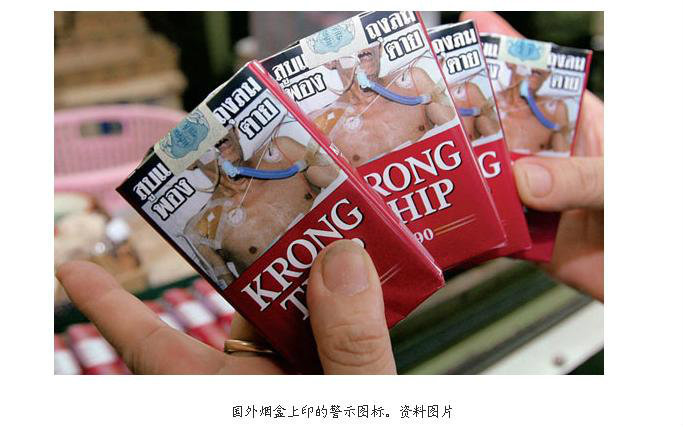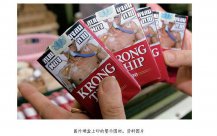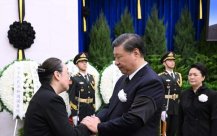In China, every packet of cigarettes smoke in China, the average consumption of 0.52 yuan tobacco leaves, pays 0.87 yuan for employees in the tobacco industry, paid a tax of 9.05 yuan for the country, that is, the tax share of a pack of cigarettes is the proportion of tax accounting for a pack of cigarettes to be the proportion of taxes for a pack of cigarettes.48.4 %.

Recently, the World Health Organization of Foreign Economics and Trade University of Foreign Economics and Trade has released the Reform of Tobacco Consumption Tax Tax Tax Tax Tax and Tobacco Industry Chain Research (hereinafter referred to as "Report").18.69 yuan, and further analyzed the tax, cost and profit composition of a pack of cigarettes at all aspects of the industry chain.
In the taxes of a pack of cigarettes, 65%are consumption tax, 24%are VAT, 10%are additional taxes, and 1%are tobacco leaf taxes. From this, it can be seen that the consumption tax is the head of the tobacco tax.A fiscal and tax experts close to the State Administration of Taxation introduced that the implementation of my country's consumption tax implementation is mainly regulatory and supplemented by income.In other words, the consumption tax of smokers is mainly for "banned in" to reduce the consumption of tobacco.At present, about 90%of countries around the world are levied on cigarette consumption taxes.
In September 2020, the National Health and Health Commission mentioned in a response to the CPPCC member's proposal that the tobacco control operation was a action in terms of comprehensive intervention in the factors of health influence, including "research and promotion of comprehensive taxation, price adjustment and other comprehensive synthesisMeans, improve the effectiveness of smoke control. "In the next step, the National Health and Health Commission will continue to promote the research of tobacco consumption tax policies and continuously improve the scientific and rationality of policies.
Report writer and professor Zheng Rong, a professor at the School of International Economics and Trade at the University of Foreign Economics and Trade, told reporters that although the proportion of cigarette tax per package in my country has reached 48.4 %, there is still room for further taxation.First, according to the model calculation, if the non -price non -price smoke control measures determined by the WHO reached a medium level in my country, and the tax ratio of a pack of cigarettes reached 78%, my country can achieve the goal of "adult smoking rate to 20%".Second, after 2015, my country's tobacco consumption tax rates have not increased, while smokers' tobacco payment capacity is increasing.The ultimate goal of taxation is to raise prices. In the past 7 years (2013-2020), the retail price of each bag of cigarettes has only increased by 4.43 yuan, and the "tax pain" of smokers is not significant.
A person in the public health of a long -term attention to smoke control told First Financial reporter that he reserved his effect on the effect of "increasing tobacco tax".In 2015, the state's consumption tax for tobacco products was suppressed to a certain extent.However, the effectiveness of taxation has not been maintained for too long. In the past five years, the number of people in consumer cigarettes has not been significantly reduced, and the effect of tax control is not good.At the same time, the tax burden on cigarette products is difficult to transfer to the retail price of cigarettes, and the market has a phenomenon of taxation and price increases.In addition, considering the inflation factor, after the consumption tax was adjusted in 2015, the actual price of some varieties of cigarettes did not even rise and fall.
A pack of cigarettes cost more than 60 % of smoke farmers' gross income of only 0.45 yuan
According to the aforementioned report, among cigarettes with an average retail price of 18.69 yuan, the cost is 6.12 yuan, accounting for about 30 %; the profit is 3.72 yuan, accounting for about 20 %.
TheReport estimates that The cost of a pack of cigarettes is 61%, which means that the tobacco industry can get a main business profit of 0.61 yuan for each cost of 1 yuan.This is much higher than the average cost of central enterprises 7.1%(data of 2021).
Under the high profit margin, the cost of raw materials required for making cigarettes is quite low.
TheReport found that in the total cost of 6.12 yuan for a pack of cigarettes, retail and agricultural links accounted for only 8.5%, 50%were distributed in production links, and 32%were distributed in the wholesale link.The operating costs of the production link include acquisitions and imported tobacco leaves (Tobacco leaf costs), direct materials, purchasing machines and equipment.
Among them, the cost of a pack of tobacco leaves is 0.52 yuan, accounting for 9%of the total cost, accounting for 2.7%of the smoke price.
The cost and high sales profit margin of low tobacco leaf also leads to polarization in income from employees.The report shows that in 2019, the average annual salary of China Tobacco Corps was 18,6700 yuan per person, which was 8,8864 yuan higher than the average annual income of employment in the manufacturing state -owned unit and the average salary of the average employment personnel of urban units.
Tobacco farmers are the group with the least profit in the tobacco industry chain .In 2019, a total of 1 million tobacco farmers across the country, on average, the hair income obtained from each pack of smoke from each bag of smoke was 0.45 yuan. Including all material costs and time costs of smoke farmers during planting.
From the perspective of Wang Jing, director of the Propaganda Department of Biological Diversity and Green Development Foundation of China, to obtain a 0.45 yuan gross income, the time and energy of smokers need to pour very much."Because the tobacco leaves are gradually mature during the growth process, tobacco farmers need to be mature to harvest a leaf, which almost depends on artificially. It can even be said that from the beginning to the first grilled."
With the continuous reduction of costs in the tobacco industry, from 2013 to 2020, the proportion of costs in a pack of cigarettes overall showed a downward trend.Among them, 2015 decreased by 3 percentage points; in 2016, it rose slightly, and then continued to decline.The proportion of a pack of cigarettes maintains a relatively stable level at the same time and shows an upward trend after 2019.
TheReport found that the proportion of tax and profit show a significant symmetrical structure, which is obvious.In 2015, my country's cigarette consumption tax was increased. In that year, the proportion of taxes in a bag of cigarette retail prices increased by 4 percentage points, and the proportion of a pack of cigarettes declined significantly in 2015 to 2016.
Experts: By 2030 tobacco products should be taxed to 78 %
"In 2022, the number of Chinese died due to smoking has exceeded 1 million. Cancer closely related to smoking is the central small -cell lung cancer, with a correlation of more than 95%. In addition, the incidence and mortality rate of lung cancer in my country still still The first five -year survival rate for lung cancer does not exceed 30%. According to the introduction, at present, more effective tobacco control measures are urgent to reduce the risk of lung cancer death.
The so -called "effective tobacco control measures", according to the World Health Organization Tobacco Control Framework Convention, have six. Among them, "improving tobacco tax" is regarded by the industry as an effective measure.
"It should be said that my country’ s tobacco products not only have room for further taxation, but also have further strengthened the management and improvement of the space for “accepting the management of the management.” Focusing on the regulatory function, its fiscal revenue functions are secondary.At present, my country's consumption tax income accounts for not high, but its regulation function is increasingly prominent.In addition, increasing tobacco tax does not necessarily cause government income to decrease.Studies have shown that in 2015, China ’s cigarette consumption tax was adjusted, and the negative cigarette tax increased by 4%, retail prices increased by 10%, and tobacco tax revenue increased by 9%.
According to the data of the tobacco industry, Zheng Rong's team calculated that the conclusion: The proportion of taxes (48.4%) of a packet of cigarettes in 2020 is not only lower than the level of 75%recommended by the WHO, but also low. The level of theoretical tax burden based on my country's tobacco tax system and market structure is 54%. In addition, in the moment when the value -added tax is fully reduced, it is more critical to increase the consumption tax of the tobacco industry.
If you refer to the established goals of "Healthy China 2030", 75 % of the tax proportion is still not enough.Action of Health China (2019-2030) clearly stated that by 2030, the smoking rate of people over the age of 15 will be less than 20%.
Zheng Rong said that because the level of implementation and implementation of various non -price measures before 2030 cannot be predicted, the team's middle level between the upper limit and the lower limit, that is, assume that non -price measures are promoted in an orderly manner at the current level, and various items are promoted.When the measures basically meet the middle or above level of the World Health Organization, it can be roughly inferred that the target that will reduce the smoking rate to 20%in 2030.Increased by 43 yuan, of which tobacco tax was 48 yuan, an increase of 40 yuan over 2020, the consumption tax was 36 yuan, an increase of 30 yuan from 2020, the proportion of retail prices in 2030 was 78%, an increase of 24 percentage points from 2020.
"Tobacco tax revenue will reach 3.3 trillion yuan, of which Tobacco consumption tax revenue will reach 2.5 trillion yuan, an increase of 273%and 236%over 2020," Zheng Rong said.
A expert close to the National Health and Health Commission believes that it is difficult to achieve the planning target of "adult smoking rates below 20 %" by relying on health tools without using economic tools.In addition, tobacco control is a cost -effective health intervention measure.At present, the direct and indirect economic burden brought by Tobacco -related diseases accounts for about 1.7%of the national GDP, and the cost of treatment has also reached about 7%of the entire national health department.Related calculations show that if the smoking rate is reduced to 20 %, it can reduce medical expenses of 200 billion yuan in the country.
Cui Xiaobo, a professor at the School of Public Health of the Capital Medical University and the vice chairman of the Beijing Municipal Control of Smoking Association, believes that compared with high -income groups, it has higher sensitivity to tobacco taxes for low -income groups.In other words, by improving the tobacco tax, it can reduce the purchase behavior of low -income groups, especially young groups, and promote the transformation of smokers' structure. This is a positive intervention measure.
There are also fiscal and tax experts that 48.4 % of the tax ratio in the report is a small caliber statistics.Under the special national conditions of my country, in addition to consumption tax, some profit in the tobacco industry will be paid to the state treasury.Whether the profit tax paid by tobacco companies should be included in the calculation scope of the proportion of taxation is a place where my country and WHO have always been controversial, which is also related to improving the feasibility of consumption tax and landing plan.
Consumption tax reform affects geometry?
In addition to directly increasing tobacco tax, the current consumption tax reform is also a direct impact on the production and sales of the tobacco industry.
At the end of 2019, the Ministry of Finance and the State Administration of Taxation issued the Consumer Tax Law of the People's Republic of China (draft for comments).According to the recently disclosed legislative work plan, in the field of taxation, the draft consumption tax law is used as a preparatory review project.
There are two directions for the reform of consumption tax: First, the current consumer tax items levied in the production (import) section under the premise of controlling the management (imported) section are gradually moved back to the wholesale or retail collection.Improve the consumption environment; the second is the quotation of the existing part of the stock tax reform and adjustment, which will be solved by the local area. In principle, the incremental part will belong to the place to ensure that the central and local financial patterns are stable.
Because the taxpayment of tobacco products accounts for a large proportion, and the tobacco monopoly system ensures that consumption taxes for tobacco products in business links are more controllable than other goods in terms of tax collection and management.After the collection, the move will be moved first to implement tobacco products.
Wang Ping, a professor at the Law Department of Beijing United University, publicly stated publicly on the day before that it was feasible to move the taxation links including smoke products in the internal taxable consumer goods to the sales link.On the one hand, this is conducive to highlighting the "tax pain" of consumers. On the other hand, under my country's tobacco monopoly system, the production and sales of tobacco products are strictly planned. Sales and consumption are distributed throughout the country.The post -movement of the collection process can solve the problem of distortion and departure from the inconsistency of economic behavior land and tax revenue to a certain extent.
If the consumption tax is levied from the production link to the business link (wholesale or retail session), and some consumption tax income belongs to the place, Zheng Rong puts forward a little concern for reporters: the key factor of the consumption tax reform is to verify the base.Local tax retention.Based on the consideration of local tax revenue, local governments will inevitably take advantage of measures to stimulate local cigarette consumption, and it is even likely that before the consumption tax reform dust is settled, it will prevent local smoke -free legislation, and even interfere with the introductory of the smokeless legislation that has been introduced.Implementation.




